
USS Underhill (DE-682) was a Buckley-class destroyer escort of the United States Navy during World War II. Built in 1943, she served in the Atlantic, the Mediterranean, and the Pacific until her sinking in a suicide attack by a Japanese Kaiten manned torpedo on 24 July 1945.
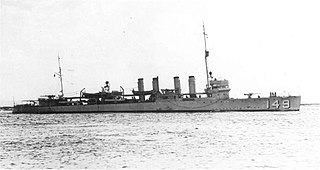
USS Barney (DD–149) was a Wickes-class destroyer in the United States Navy during World War II, later redesignated AG-113. She was the second ship named for Commodore Joshua Barney.
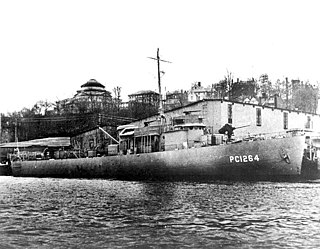
USS PC-1264 was a PC-461-class submarine chaser built for the United States Navy during World War II. She was one of only two U.S. Navy ships to have a predominantly African-American enlisted complement during the war, the other being the Evarts-class destroyer escortUSS Mason.
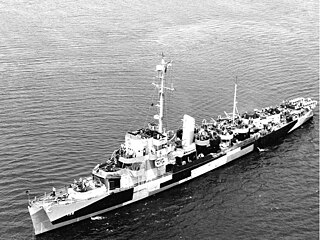
USS Peterson (DE–152) was an Edsall class destroyer escort, the first United States Navy ship so named. This ship was named for Chief Water Tender Oscar V. Peterson (1899–1942), who was awarded the Medal of Honor posthumously for his actions during the Battle of the Coral Sea.
USS PC-1141 was a PC-461-class submarine chaser built for the United States Navy during World War II. She was renamed USS Pierre (PC-1141) in 1956, was decommissioned from the U.S. Navy in October 1958, and transferred to the Indonesian Navy as KRI Tjakalang.

USS Mason (DE-529), an Evarts-class destroyer escort, was the second ship of the United States Navy to be named Mason, though DE-529 was the only one specifically named for Ensign Newton Henry Mason. USS Mason was one of two US Navy ships with largely African-American crews in World War II. The other was USS PC-1264, a submarine chaser. These two ships were manned by African Americans as the result of a letter sent to President Roosevelt by the NAACP in mid-December 1941. Entering service in 1944, the vessel was used for convoy duty in the Battle of the Atlantic for the remainder of the war. Following the war, Mason was sold for scrap and broken up in 1947.

USS Stewart (DE–238) is an Edsall-class destroyer escort, the third United States Navy ship so named. This ship was named for Rear Admiral Charles Stewart, who commanded USS Constitution during the War of 1812. Stewart is one of only two preserved destroyer escorts in the U.S. and is the only Edsall-class vessel to be preserved. She is on display in Galveston TX as a museum ship and is open to the public.

USS Zeus (ARB-4) was planned as a United States Navy LST-1-class tank landing ship, but was redesignated as one of twelve Aristaeus-class battle damage repair ships built for the United States Navy during World War II. Named for Zeus, she was the only US Naval vessel to bear the name.

USS Magpie (AMS-26/YMS-400) was a YMS-1-class minesweeper of the YMS-135 subclass built for the United States Navy during World War II.
USS PC-465 was a PC-461-class submarine chaser built for the United States Navy during World War II. She was later renamed Paragould (PC-465) but never saw active service under that name. In 1961 she was transferred to the Venezuelan Navy under the name ARV Pulpo (P-7). She remained active in Venezuelan service until 1968, when she was placed in reserve. She was stricken in 1978 but her ultimate fate is unknown.

USS Booth (DE-170) was a Cannon-class destroyer escort built for the United States Navy during World War II. She served in the Atlantic Ocean and then the Pacific Ocean and provided escort service against submarine and air attack for Navy vessels and convoys.

USS Gustafson (DE-182) was a Cannon-class destroyer escort in service with the United States Navy from 1943 to 1946. In 1950, she was transferred to the Royal Netherlands Navy where she served as Hr.Ms. Van Ewijck (F808) until 1967. She was scrapped in 1968.
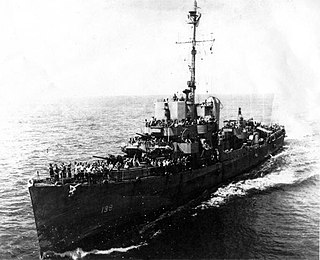
USS Farquhar (DE-139) was an Edsall-class destroyer escort in service with the U.S. Navy from 1943 to 1946. She was scrapped in 1974.

USS Blair (DE-147) was an Edsall-class destroyer escort in service with the United States Navy from 1943 to 1946 and from 1951 to 1960. She was scrapped in 1974. Blair was named in honor of Chief Machinist's Mate Eugene Blair, who was awarded the Silver Star posthumously for his brave actions when his ship was attacked and bombed by Japanese planes near Port Darwin, Australia, in mid-February 1942.

USS Neunzer (DE-150) was an Edsall-class destroyer escort in service with the United States Navy from 1943 to 1947. After spending several decades in reserve, she was sold for scrap in 1973.

USS Tweedy (DE-532) was a John C. Butler-class destroyer escort in service with the United States Navy from 1944 to 1946 and from 1952 to 1969. She was sunk as a target in 1970.
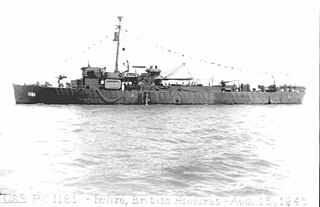
USS PC-1181 was a PC-461-class submarine chaser built for the United States Navy during World War II. She was later renamed Wildwood (PC-1181) but never saw active service under that name.

USS Bassett (APD-73), ex-DE-672, was a United States Navy high-speed transport in commission from 1945 to 1946 and from 1950 to 1957.

USS Valiant (PYc-51), originally USS PC-509, was a United States Navy patrol vessel in commission from 1941 to 1944.

USS PC-552 was a class-461 patrol craft ("PC") that was at the forefront of the naval efforts during the Normandy invasion. It served as convoy protection in the North Atlantic and as one of about ten PC control vessels off Omaha Beach during the Normandy invasion. PC-552 was among the first ships to reach waters off Omaha Beach. PC-552, primary control vessel for Fox Green sector of the beach, was forced into rescue efforts and recovery of bodies at the departure line for Fox Green when the Duplex Drive tanks that survived the initial disastrous launch were swamped at the line with only two surviving. The PC was diverted into this effort for forty-five minutes and ultimately only five tanks, the two that survived the launch disaster and three that were aboard LCT-600 whose commander raised his ramp when the first off foundered and instead landed them on the beach, reached the beach.

















